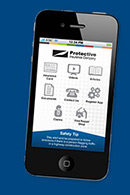| Look out behind you! Safe backing and proper mirror adjustment |
| Serious collisions involving backing and sideswipe maneuvers can occur on the road, at the station/terminal, in residential areas and anywhere you back. These collisions and the resulting injuries and fatalities can be avoided through safe backing and proper mirror adjustment. |
| The most important rule for safe backing is to do so only when absolutely necessary. The objective is to reduce the number of times you need to back your vehicle and to get out and look (G.O.A.L.) when you do have to back. Never take a chance, even if you think you are sure. A couple of seconds of safety could keep you from catastrophic results. |
| How to perform a safe backing maneuver |
| First, determine if you will need to back prior to arriving at your stop. Scan the area as you approach, looking for overhead hazards, adequate clearances and obstacles, then get out and look to be sure. If possible, back to the driver’s side as it has fewer blind spots and use a co-driver or helper to assist if available. Your guide must check not only the ground path but the overhead path as well to prevent collisions with overhead objects. Discuss your communication signals in advance to prevent misunderstanding. If your guide disappears from your view, STOP! |
| Roll down your window and turn off your radio, heater or anything that may prevent you from hearing a potential warning of danger. Signal your intentions and alert pedestrians and other vehicles using your 4-way flashers and horn and make eye contact with those in the area. Continue to tap your horn as you back and periodically get out and look yourself to make sure conditions haven’t changed, even if others are telling you it’s safe. |
| Back at a slow and controlled speed, equivalent to a walking pace, to allow time to react should the environment change abruptly. Use all of your mirrors, checking them during the back as well as checking over your shoulder to minimize potential blind spots. |
| Proper mirror adjustment |
| Properly adjusted mirrors can significantly reduce blind spots and improve reaction time. As part of your daily pre-trip inspection, note defective, loose, cracked or broken mirrors and brackets. Here are some tips for adjusting mirrors: |
| • Sit in your normal driving position with your seat adjusted and your seat belt buckled. |
| • Adjust the side convex mirrors horizontally (move side to side) so the side of the vehicle is barely visible. Adjust vertically (tilt up and down) so the horizon is just out of sight. |
| • Adjust the side flat mirrors horizontally so the rear corner of the vehicle is barely visible. Adjust vertically so the horizon is in view in about 1/3 of the mirror and the ground in 2/3. |
| • Consult with your safety director so you fully understand the different functions and proper adjustments for each mirror configuration. |
| • Keep mirrors clean at all times so your view is not distorted. |
| • Every mirror has its limitations. Moving your head slightly from side to side and forward/backward will help blind spots come into better view. |
| Download our Mirror Adjustment Station Guide for more information on ensuring your mirrors are in proper position to help you avoid collisions. |
| Free download: Mirror Adjustment Station Guide |
| Learn how to set up a mirror adjustment station at your facility to ensure proper mirror alignment. Download guide >>
|
|
| Download the Protective mobile app!
|
| The Protective mobile app enables customers to easily submit claims, view vehicle ID cards, get the latest safety updates and more. Click to download for iPhone or Android today! |
| Note: Not all features are available to all customers. Please refer to the app's description in the App Store or Google Play for full details. |
|  |
|
